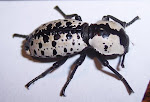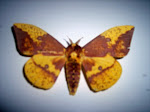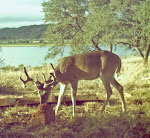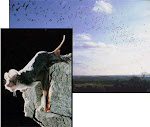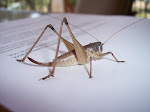The sun won’t be up for a little while, so it is kind of early to be thinking about anything but the coffee perking. That leaves me two options: (1) sodoku, or (2) picking a subject for this month’s “Our Creatures…….”. It is too early to think clearly so I will leave this decision to Mother Nature.
I’m going to wait until there is a little light and walk out on my back porch, which is open to a field and Canyon Lake beyond. The first critter I see is going to get the business, meaning I’ll research and write it up. If I don’t see any animal, I’m going back to my sodoku puzzles. (I suspect that I will see some kind of bird, since they are so active at dawn.) Here goes…….
Well, that didn’t turn out as expected. I didn’t get a full step out of my kitchen door when I noticed what looked like bird droppings beside my “Welcome to the Lake” mat. I thought that strange, because there isn’t any place for a bird to perch nearby and I gave it a closer look. Lo and behold, it had six legs. Bird poop with six legs! Will wonders never cease?
There are more than 800,000 different species of insects in the world, which is as much as all other animals and plants combined. Interestingly, almost half of those insect species are different kinds of beetles. Amongst this wondrous diversity of beetles, I just found one that my readers can relate to here at Canyon Lake.
Allow me to introduce the “Ironclad Beetle” to all you fans who prefer Coleoptera to Cleopatra.
(Kingdom; Animalia, Phylum; Arthropoda, Class; Insecta, Order; Coleoptera, Family; Zopheridae, Genus: Zopherus, Species: Z. haldemani Horn)
This little trickster has a number of unique characteristics that make him a standout in the world of beetles, but first let’s talk about his distribution.
One source says that this species of the Ironclad Beetle is found in areas of “south-central Texas” and has been positively identified at Canyon Lake, Texas; Ames, Texas; and Georgetown, Texas. I don’t know where Ames is and Georgetown, of course, doesn’t count so I claim that this is our very own beetle here at Canyon Lake. We must not be selfish, however, so let’s share some information with our jealous neighbors who unfortunately don’t have their own bug.
The Ironclad Beetle is a slow moving insect, and it may be the slowest insect for its size that you will ever encounter. I placed this one in the center of a sheet of paper on my desk and it took the beetle five minutes to untuck its legs and begin to move. It then took eight minutes to reach the edge of the paper, a distance of about five inches. It apparently does not need speed to escape predation. I’m speculating here but I think that this slow motion routine may be an effective defense against some predators. Lizards, for example, often notice their prey because of abrupt movement. Anyway, the Ironclad Beetle has other tricks up his six sleeves.
If disturbed on a tree trunk, it will tuck in its legs and fall to the ground, where it is virtually undetectable due to its camouflage.
Its striking black and creamy white spotted coloration is also the perfect camouflage when sitting on the bark of our Live Oak trees. If, however, some sharp eyed predator does happen to notice it, it looks for all the world like an unappetizing piece of bird poop.
The beetle’s common name of “Ironclad” is appropriate and they are indeed tough. The exoskeleton (integument) is extremely hard and thick and reminds one of a walnut shell. I imagine that many a strong lad has lost a bet that he could crush the beetle between thumb and forefinger.
Ironclad Beetles are also unique in that they don’t fly. Most beetles have a pair of leathery protective wings called elytra that cover their membranous flight wings. During flight, the elytra are spread apart and the two flight wings are unfolded and extended (think of a June bug or a Ladybug). Our Ironclad Beetles are missing the primary flight wings and the elytra are thick, hard and fused together.
These beetles have not been studied real thoroughly so little is known about their biology or habits. They do go through the egg-larvae-pupal-adult routine and it is thought that the adults feed nocturnally on lichens growing on the bark of Oak and Pecan trees. Around here, the adults can be found in the summer on the outer walls of homes in wooded areas. They are long lived and have been known to survive for seven years in captivity.
Our Ironclad Beetle has no medical or economic importance that I can find. However, while most non-economically important insects do not carry a common name, the Entomological Society of America has honored this beetle by officially approving “Southwestern Ironclad Beetle”. It is also the symbol of the Southwestern Entomological Society, a regional society of insect scientists.
I think it is nice that they choose “Our” very own beetle as their symbol.
Clay
